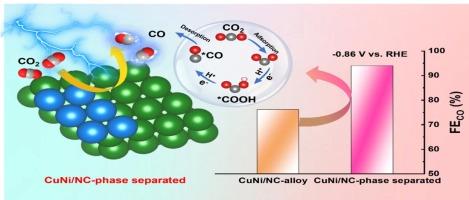当前位置:
X-MOL 学术
›
Appl. Surf. Sci.
›
论文详情
Our official English website, www.x-mol.net, welcomes your
feedback! (Note: you will need to create a separate account there.)
Unlocking the potential of CuNi bimetallic catalyst: Structural innovation in phase-separated design for efficient electrochemical CO2 reduction
Applied Surface Science ( IF 6.3 ) Pub Date : 2024-11-20 , DOI: 10.1016/j.apsusc.2024.161864 Min Li, Yutao Cao, Jiaqi Dang, Shuo Cui, Wei Cui, Zengxi Li, Hong Zhao
Applied Surface Science ( IF 6.3 ) Pub Date : 2024-11-20 , DOI: 10.1016/j.apsusc.2024.161864 Min Li, Yutao Cao, Jiaqi Dang, Shuo Cui, Wei Cui, Zengxi Li, Hong Zhao

|
Bimetallic catalysts are widely used in electrochemical CO2 reduction reactions (ECRR). However, the study of structural effects of bimetallic catalysts on ECRR is still limited. Herein, two kinds of nitrogen-doped carbon-supported CuNi bimetallic catalysts with alloy structure (CuNi/NC-alloy) and phase-separated structure (CuNi/NC-PS) were prepared, respectively, and their ECRR performance were studied. Interestingly, compared with CuNi/NC-alloy, the unique phase separation structure in the CuNi/NC-PS catalyst made the d-band center of Ni the most moderate, balancing the bonding strength with *COOH and *CO, making it not only exhibited relatively low CO2 activation barrier but also not been poisoned by CO, thus exhibiting higher CO selectivity. Therefore, CuNi/NC-PS exhibited superior catalytic activity (−0.86 V vs. RHE, FECO = 94.03 %, j CO = 37.06 mA cm−2 ) compared to CuNi/NC-alloy. In the membrane electrode assembly, based on CuNi/NC-PS catalyst and Co/Mo metal–organic frameworks (Co/Mo-MOF) catalyst, the coupling of formaldehyde oxidation and CO2 reduction could save 22 % energy consumption at the current density of 100 mA cm−2 and obtain high value-added anode product HCOO− . This study will lay a foundation for understanding the structural effects of CuNi based bimetallic catalysts on their electrocatalytic activities.
中文翻译:

释放 CuNi 双金属催化剂的潜力:用于高效电化学 CO2 还原的相分离设计的结构创新
双金属催化剂广泛用于电化学 CO2 还原反应 (ECRR)。然而,双金属催化剂对 ECRR 的结构影响的研究仍然有限。本文分别制备了两种具有合金结构(CuNi/NC合金)和相分离结构(CuNi/NC-PS)的氮掺杂碳负载CuNi双金属催化剂,并研究了它们的ECRR性能。有趣的是,与 CuNi/NC 合金相比,CuNi/NC-PS 催化剂中独特的相分离结构使 Ni 的 d 带中心最适中,平衡了与 *COOH 和 *CO 的键合强度,使其不仅表现出相对较低的 CO2 活化势垒,而且没有受到 CO 的毒害,从而表现出更高的 CO 选择性。因此,与 CuNi/NC 合金相比,CuNi/NC-PS 表现出优异的催化活性(-0.86 V vs. RHE,FECO = 94.03 %,jCO = 37.06 mA cm-2)。在膜电极组件中,基于 CuNi/NC-PS 催化剂和 Co/Mo 金属有机框架 (Co/Mo-MOF) 催化剂,甲醛氧化和 CO2 还原的耦合可在 100 mA cm−2 的电流密度下节省 22 % 的能耗,并获得高附加值的负极产品 HCOO−。本研究将为理解 CuNi 基双金属催化剂的结构效应对其电催化活性的影响奠定基础。
更新日期:2024-11-20
中文翻译:

释放 CuNi 双金属催化剂的潜力:用于高效电化学 CO2 还原的相分离设计的结构创新
双金属催化剂广泛用于电化学 CO2 还原反应 (ECRR)。然而,双金属催化剂对 ECRR 的结构影响的研究仍然有限。本文分别制备了两种具有合金结构(CuNi/NC合金)和相分离结构(CuNi/NC-PS)的氮掺杂碳负载CuNi双金属催化剂,并研究了它们的ECRR性能。有趣的是,与 CuNi/NC 合金相比,CuNi/NC-PS 催化剂中独特的相分离结构使 Ni 的 d 带中心最适中,平衡了与 *COOH 和 *CO 的键合强度,使其不仅表现出相对较低的 CO2 活化势垒,而且没有受到 CO 的毒害,从而表现出更高的 CO 选择性。因此,与 CuNi/NC 合金相比,CuNi/NC-PS 表现出优异的催化活性(-0.86 V vs. RHE,FECO = 94.03 %,jCO = 37.06 mA cm-2)。在膜电极组件中,基于 CuNi/NC-PS 催化剂和 Co/Mo 金属有机框架 (Co/Mo-MOF) 催化剂,甲醛氧化和 CO2 还原的耦合可在 100 mA cm−2 的电流密度下节省 22 % 的能耗,并获得高附加值的负极产品 HCOO−。本研究将为理解 CuNi 基双金属催化剂的结构效应对其电催化活性的影响奠定基础。































 京公网安备 11010802027423号
京公网安备 11010802027423号